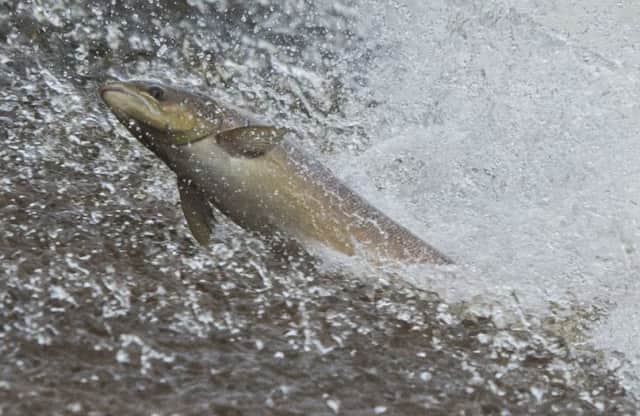Scottish fisherman sees salmon catch fall from hundreds to zero


Dougie MacDougall says he has also suffered three potentially life-threatening diseases that he attributes to clearing rotten seaweed by hand from the shoreline.
The pensioner has been logging the number of salmon he’s caught since 1995 and in the last nine years says he’s landed just one salmon, destroying his family business.
Advertisement
Hide AdAdvertisement
Hide AdHe is urging Scotland’s environmental agency to carry out more comprehensive testing of water quality of the Inner Moray Firth, a request backed by the local fisheries board.
Scottish Water insists that its Allanfearn waste water treatment works (WWTW), which is operated on its behalf by Veolia UK, is “fully regulated by the Scottish Environment Agency (SEPA) and any sewage leaving the plant is fully compliant with all licence requirements.”
Mr MacDougall, however, claims the scale of raw sewage pumped into the firth waters around Alturlie Point has forced the salmon further out.
He said: “The water’s absolutely polluted. I’ve been fishing there since 1958 and we’ve always had trouble with sewage but it’s been getting worse each year.
“Pollution in the firth has to be proved but to do that would cost hundreds of thousands of pounds, which I can’t afford.”
The Argyll-born netsman moved to Alturlie with his wife and six daughters in the 1960s. His primary job was forestry but the family previously made hundreds of pounds in the summer months from the fishing.
“I don’t want to give up,” Mr MacDougall said. “It won’t affect me, as I’m retired now. But it’s a family business – the last traditional family business of its type. I’d love to have this sorted for the family before I die.”
Mr MacDougal said even when he contracted three severe infections from the sewage polluted seaweed “nobody believed me.”
Advertisement
Hide AdAdvertisement
Hide AdHis medical records show he acquired a urine infection in 1991, a bowel infection in 1998 and a stomach infection in 2004 – all of which he blames on “polluted seaweed”.
Mr MacDougall says he was told by the region’s director of public health that he was more likely to have acquired his stomach virus campylobacter from “raw chicken”.
About four out of five cases of campylobacter poisoning in the UK come from contaminated poultry but it is also found untreated water. Mr MacDouglall maintains the infection came from the seaweed as none of his family was affected – and they had all eaten the same food.
He raised his concerns with several generations of local politicians, from the late Liberal MP Russell Johnston to former Scottish rural affairs secretary Richard Lochhead and, most recently – in 2011 – with Green MSP John Finnie.
He believes that when salmon heading for their original spawning rivers reach narrow water by Fort George they steer clear of “polluted water” and divert further out, giving the Chanonry Point dolphins a heyday.
Mr MacDougall says the impact of the sewage is easily measured by increasingly wider seagull movements, as the birds follow the flow of effluent.
He currently pays £250 a year for exclusive netting rights for the local stretch of coastline and £150 to the local fishery board.
Chris Conroy, director of the Ness District Salmon Fishery Board said: “Mr MacDougall contacted us recently. We’re asking SEPA to take a closer – and wider – look at water quality around the Firth to ensure they’re not missing something.
Advertisement
Hide AdAdvertisement
Hide Ad“On a national level, salmon numbers are declining, there’s no doubt about that. Our Ness catches follow the national trend quite closely.
“If you go back 20 or 30 years, you were probably getting 50 percent of the salmon that left fresh water returning as adults. Now, we’re looking at about two percent. There are real issues at sea and I believe it’s to do with climate change.”
A spokesman for SEPA said: “We take all complaints very seriously. Following a full and thorough investigation we’ve not been able to substantiate complaints regarding discharges from the Allanfearn works.
“The site is currently rated as ‘excellent’ in our compliance assessment scheme. Recent samples of the treated effluent have consistently complied with the required standards.
“Under the Water Framework Directive, the Inner Moray Firth is currently classed as ‘good’ status.
“We’ve invited Mr MacDougall to visit the plant to give him the opportunity to ask questions. If anyone has information about any potential pollution in the area we’d advise them to call our hotline on 0800 807060.
A spokesman for Scottish Water said the quality of the effluent discharge had improved significantly since 2001 when the plant was “fully upgraded to provide much more comprehensive levels of treatment in order to meet the requirements of European legislation.”
Dougal MacDougall’s salmon catches (June to August for six hours, five days a week, weather permitting)...
1994 255
1995 185
1996 42
1997 32
1998 19
1999 5
2000 47
2001 55
2002 30
2003 24
2004 26
2005 32
2006 19
2007 9
2008 0
2009 1
2010-2017 0